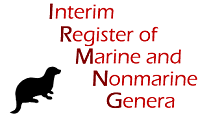
| Intro | | Search taxa | | Taxon tree | | Search literature | | Taxon match | | Homonyms | | Statistics | | Webservice | | Manual | | FAQ | | LifeWatch | | Download | | Log in |
IRMNG taxon detailsAiladinium M. Saburoa & N. Chomérat, 2014
marine,
recent only
Saburova, M.; Chomérat, N. (2014). Ailadinium reticulatum gen. et sp. nov. (Dinophyceae), a new thecate, marine, sand-dwelling dinoflagellate from the northern Red Sea. <em>Journal of Phycology.</em> 50(6): 1120-1136., available online at https://doi.org/10.1111/jpy.12244 [details]
Taxonomic remark From original work: Phylogenetic analyses based on the SSU and LSU rDNA genes did not show any supported affinities with...
Taxonomic remark From original work: Phylogenetic analyses based on the SSU and LSU rDNA genes did not show any supported affinities with currently known thecate dinoflagellates. [details]
IRMNG (2021). Ailadinium M. Saburoa & N. Chomérat, 2014. Accessed at: https://www.irmng.org/aphia.php?p=taxdetails&id=11903731 on 2025-09-11
Date action by 2016-10-03 08:53:49Z created db_admin
original description
Saburova, M.; Chomérat, N. (2014). Ailadinium reticulatum gen. et sp. nov. (Dinophyceae), a new thecate, marine, sand-dwelling dinoflagellate from the northern Red Sea. <em>Journal of Phycology.</em> 50(6): 1120-1136., available online at https://doi.org/10.1111/jpy.12244 [details]
basis of record Saburova, M.; Chomérat, N. (2014). Ailadinium reticulatum gen. et sp. nov. (Dinophyceae), a new thecate, marine, sand-dwelling dinoflagellate from the northern Red Sea. <em>Journal of Phycology.</em> 50(6): 1120-1136., available online at https://doi.org/10.1111/jpy.12244 [details] verified source for family Saburova, M.; Chomérat, N. (2014). Ailadinium reticulatum gen. et sp. nov. (Dinophyceae), a new thecate, marine, sand-dwelling dinoflagellate from the northern Red Sea. <em>Journal of Phycology.</em> 50(6): 1120-1136., available online at https://doi.org/10.1111/jpy.12244 note: as Peridiniphycideae incertae sedis [details] name verified source Saburova, M.; Chomérat, N. (2014). Ailadinium reticulatum gen. et sp. nov. (Dinophyceae), a new thecate, marine, sand-dwelling dinoflagellate from the northern Red Sea. <em>Journal of Phycology.</em> 50(6): 1120-1136., available online at https://doi.org/10.1111/jpy.12244 [details] current name source WoRMS (2016). [details] extant flag source Saburova, M.; Chomérat, N. (2014). Ailadinium reticulatum gen. et sp. nov. (Dinophyceae), a new thecate, marine, sand-dwelling dinoflagellate from the northern Red Sea. <em>Journal of Phycology.</em> 50(6): 1120-1136., available online at https://doi.org/10.1111/jpy.12244 [details] habitat flag source Saburova, M.; Chomérat, N. (2014). Ailadinium reticulatum gen. et sp. nov. (Dinophyceae), a new thecate, marine, sand-dwelling dinoflagellate from the northern Red Sea. <em>Journal of Phycology.</em> 50(6): 1120-1136., available online at https://doi.org/10.1111/jpy.12244 [details] Unreviewed
Taxonomic remark From original work: Phylogenetic analyses based on the SSU and LSU rDNA genes did not show any supported affinities with currently known thecate dinoflagellates. [details]
|